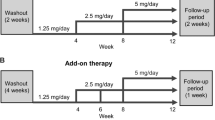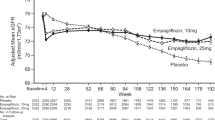Abstract
Diabetic patients with hypertension are at particularly high risk of vascular damage and consequently cardiovascular and renal disease. Fibulin-1, an extracellular matrix glycoprotein, is increased in arterial tissue and plasma from individuals with type 2 diabetes. This study aimed to evaluate whether antihypertensive treatment with spironolactone changes plasma fibulin-1 levels. In a multicenter, double-blind, randomized, placebo-controlled study, 119 patients with type 2 diabetes and resistant hypertension were included. A dose of spironolactone 25 mg or matching placebo was added to previous treatment at randomization. Blood pressure (BP) and plasma fibulin-1 were measured at baseline and at 16 weeks follow-up. Overall, 112 patients completed the study. All measures of BP were reduced in the spironolactone group at follow-up. Plasma fibulin-1 was significantly reduced after spironolactone treatment (P=0.009), but increased after placebo (P=0.017). Baseline plasma fibulin-1 correlated with BP and estimated glomerular filtration rate. Increased levels of plasma fibulin-1 (P=0.004) were observed in diabetic participants reporting erectile dysfunction as compared with participants who did not. Treatment with low-dose spironolactone reduced plasma fibulin-1 levels in patients with type 2 diabetes and resistant hypertension. This supports the hypothesis that the antihypertensive effect of the mineralocorticoid receptor blocker in part may be due to regression of vascular remodeling.
This is a preview of subscription content, access via your institution
Access options
Subscribe to this journal
Receive 12 digital issues and online access to articles
$119.00 per year
only $9.92 per issue
Buy this article
- Purchase on Springer Link
- Instant access to full article PDF
Prices may be subject to local taxes which are calculated during checkout


Similar content being viewed by others
References
Ferrannini E, Cushman WC . Diabetes and hypertension: the bad companions. Lancet 2012; 380 (9841): 601–610.
Naka KK, Papathanassiou K, Bechlioulis A, Kazakos N, Pappas K, Tigas S et al. Determinants of vascular function in patients with type 2 diabetes. Cardiovasc Diabetol 2012; 11: 127.
Cooper-DeHoff RM, Gong Y, Handberg EM, Bavry AA, Denardo SJ, Bakris GL et al. Tight blood pressure control and cardiovascular outcomes among antihypertensive patiets with diabets and coronary disease. JAMA 2010; 304: 61–68.
Calhoun DA, Jones D, Textor S, Goff DC, Murphy TP, Toto RD et al. Resistant hypertension: diagnosis, evaluation, and treatment: a scientific statement from the American Heart Association Professional Education Committee of the Council for High Blood Pressure Research. Circulation 2008; 117 (25): e510–e526.
Vaclavik J, Sedlak R, Plachy M, Navratil K, Plasek J, Jarkovsky J et al. Addition of spironolactone in patients with resistant arterial hypertension (ASPIRANT): a randomized, double-blind, placebo-controlled trial. Hypertension 2011; 57 (6): 1069–1075.
Briet M, Schriffrin EL . Vascular actions of aldosterone. J Vacs Res 2013; 50: 89–99.
Bender SB, McGraw AP, Jaffe IZ, James RS . Mineralocorticoid receptor-mediated vascular insulin resistance. An early contributor to diabetes-related vascular disease. Diabetes 2013; 62 (2): 313–319.
Cangemi C, Skov V, Poulsen MK, Funder J, Twal WO, Gall MA et al. Fibulin-1 is a marker for arterial extracellular matrix alterations in type 2 diabetes. Clin Chem 2011; 57: 1556–1565.
Argraves WS, Tran H, Burgess WH, Dickerson K . Fibulin is an extracellular matrix and plasma glycoprotein with repeated domain structure. J Cell Biol 1990; 111: 3155–3164.
Argraves WS, Dickerson K, Burgess WH, Ruoslahti E . Fibulin, a novel protein that interacts with the fibronectin receptor beta subunit cytoplasmic domain. Cell 1989; 58: 623–629.
Skov V, Knudsen S, Olesen M, Hansen ML, Rasmussen LM . Global gene expression profiling displays a network of dysregulated genes in non-atherosclerotic arterial tissue from patients with type 2 diabetes. Cardiovasc Diabetol 2012; 11: 15.
Stolze A, Bladbjerg EM, Sidelmann JJ, Diederichen ACP, Mickley H, Nybo M et al. Plasma concentrations of extracellular matrix fibulin-1 are related to cardiovascular risk markers in chronic kidney disease and diabetes. Cardiovasc Diabetol 2013; 12: 6.
Laugesen E, Høyrem P, Christiansen JS, Kundsen ST, Hansen KW, Argaves WS et al. Plasma levels of the arterial wall protein fibulin-1 are associated with carotid-femoral pulse wave velocity; a cross-sectional study. Cardiovasc Diabetol 2013; 12: 107.
Oxlund CS, Henriksen JE, Tarnow L, Schousboe K, Gram J, Jacobsen IA . Low dose spironolactone reduces blood pressure in patients with resistant hypertension and type 2 DM: a double blind randomized clinical trial. J Hypertens 2013; 31: 2094–2102.
Pitt B, Zannand F, Remme WJ, Codt R, Castaigne A, Perez A et al. The effect of spironolactone on morbidity and mortality, in patients with severe heart failure. Randomized Adalactone Evaluation Study Investigators. N Engl J Med 1999; 341: 709–717.
Druppel V, Kusche-Vihrog K, Grossmann C, Gekle M, Kadpzak B, Brand E et al. Long-term application of aldosteron antagonist spironolactone prevents stiff endothelial cell syndrome. FASEB J 2013; 27: 3652–3659.
Hsueh WA, Wyne K . Renin-angiotensin-aldosterone system in diabetes and hypertension. J Clin Hypertens (Greenwich) 2011; 13 (4): 224–237.
Shibata H, Itoh H . Mineralocorticoid receptor-associated hypertension and its organ damage: clinical relevance for resistant hypertension. Am J Hypertens 2012; 25 (5): 514–523.
Roak EF, Keene DR, Haudenschild CC, Godyna S, Little CD, Argaves WS . The association of human fibulin-1 with elastic fibers: an immunohistological, ultrastructural, and RNA study. J Histochem Cytochem 1995; 43: 401–411.
Cooley MA, Kem CB, Fresco VM, Wessels A, Thompson RP, McQuinn TC et al. Fibulin-1 is required for morphogenesis of neural crest-derived structures. Dev Biol 2008; 319 (2): 336–345.
Nehra A, Jackson G, Miner M, Billups KL, Burnett AL, Buvat J et al. Diagnosis and treatment of erectile dysfunction for reduction of cardiovascular risk. J Urol 2013; 189 (6): 2031–2038.
Guay A . Relation of endothelial cell function to erectile dysfunction: implications for treatment. Am J Cardiol 2005; 95 (suppl): 52M–56M.
Javaroni V, Neves MF . Erectile dysfunction and hypertension: impact on cardiovascular risk and treatment. Int J Hypertens 2012; 2012: 627278.
Konvanecz I, Nolazco G, Ferrini MG, Toblli JE, Heydarkhan S, Vernet D et al. Early onset if fibrosis within the arterial media in a rat model of type 2 diabetes mellitus with erectiledysfunction. BJU Int 2009; 103: 1396–1404.
Laugesen E, Rossen NB, Poulsen PL, Hansen KW, Ebbehøj E, Knudsen ST . Pulse pressure and systolic night-day ratio interact in prediction of macrovascular disease in patients with type 2 diabetes mellitus. J Hum Hypertens 2012; 26: 164–170.
Acknowledgements
The region of Southern Denmark provided financial support for this study. Study medication was donated by Nycomed, Denmark.
Author information
Authors and Affiliations
Corresponding author
Ethics declarations
Competing interests
The authors declare no conflict of interest.
Rights and permissions
About this article
Cite this article
Oxlund, C., Cangemi, C., Henriksen, J. et al. Low-dose spironolactone reduces plasma fibulin-1 levels in patients with type 2 diabetes and resistant hypertension. J Hum Hypertens 29, 28–32 (2015). https://doi.org/10.1038/jhh.2014.27
Received:
Revised:
Accepted:
Published:
Issue Date:
DOI: https://doi.org/10.1038/jhh.2014.27
This article is cited by
-
The matrix proteins aggrecan and fibulin-1 play a key role in determining aortic stiffness
Scientific Reports (2018)
-
The necessity and effectiveness of mineralocorticoid receptor antagonist in the treatment of diabetic nephropathy
Hypertension Research (2015)



